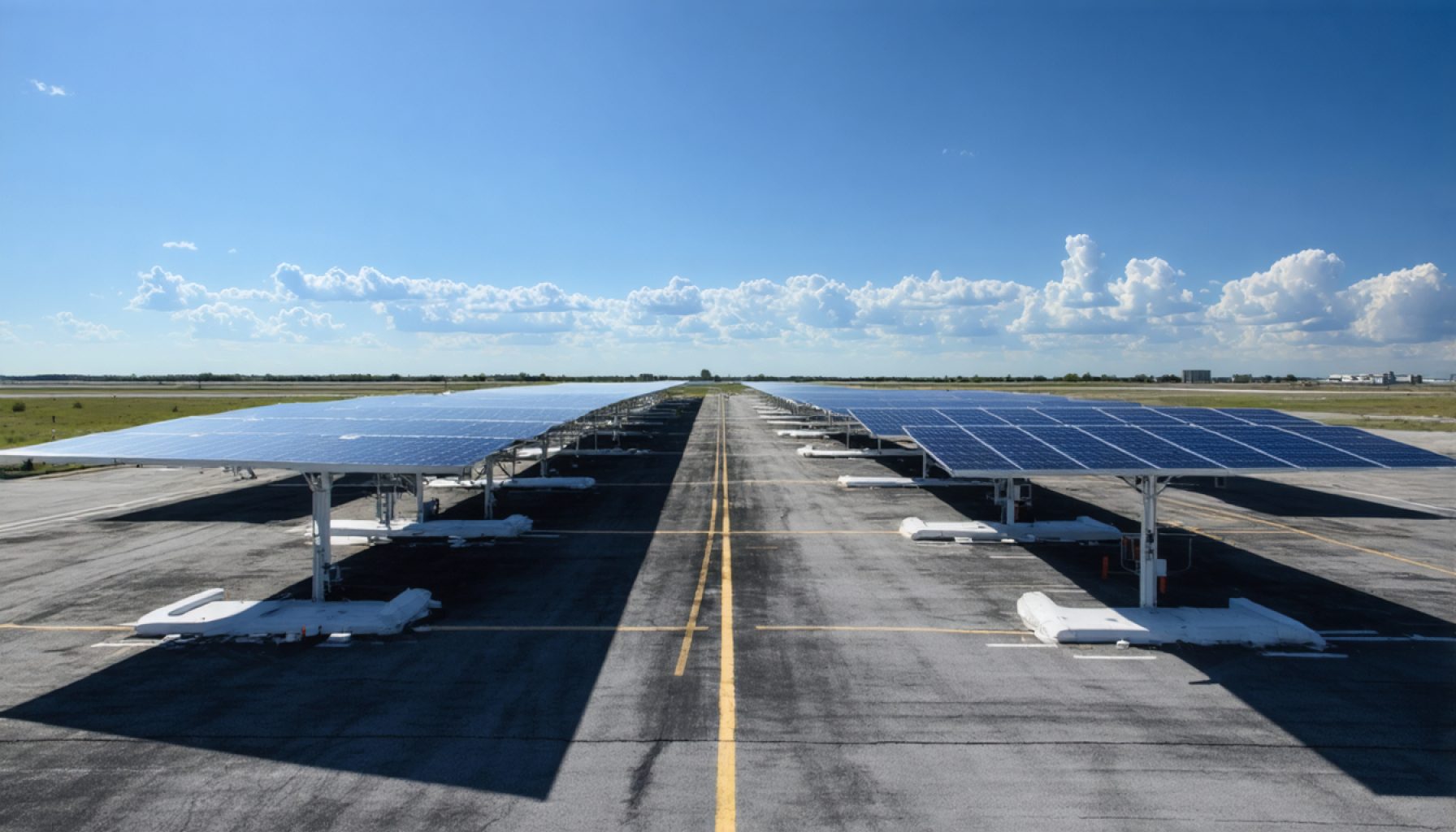- Killeen Regional Airport in Texas has unveiled a solar-integrated covered parking project, showcasing a commitment to renewable energy and environmental sustainability.
- The project, led by Ameresco, Inc., includes 1.2 MW of solar arrays that contribute to the airport’s energy independence and service multiple parking areas.
- New LED lighting has been installed throughout the airport, enhancing visibility and reducing maintenance costs.
- The initiative, supported by over $7 million in funding, largely from the FAA’s Airport Terminals Program, aims to offset 68% of the airport’s electricity consumption.
- This project represents a blend of environmental stewardship and fiscal responsibility, reducing operational expenses and enhancing the airport’s green credentials.
- The City of Killeen views this as a significant stride toward ecological accountability, underscored by strong municipal leadership and pride.
- The project serves as a model for other airports seeking sustainable solutions, highlighting the potential for transformative environmental initiatives in aviation.
As sunlight spills over the Lone Star State, a quiet revolution brews at Killeen Regional Airport, lighting up the tarmac with prospects far brighter than the morning sun. Beneath the sprawling Texas sky, a patchwork of solar panels stands proudly atop newly erected parking structures, a testament to innovation and environmental foresight. This ambitious leap into renewable energy arrives not just with technical prowess, but with a promise: to sculpt a more sustainable future, one solar watt at a time.
Ameresco, Inc., a vanguard in energy transformation, has etched a bold new chapter in energy-conscious infrastructure with the completion of this dynamic solar-integrated covered parking project. Central Texas travelers now enjoy the dual comfort of protection from the elements and the assurance that their journey begins at an airport resolutely committed to green solutions. Like shimmering scales on a great beast, the 1.2 MW solar arrays create a mosaic of energy independence, strategically placed to serve not just the terminal, but the vibrant rental and short-term parking areas.
But the story doesn’t stop with the glint of solar panels. As dusk falls, the airport unveils its second act: a comprehensive transformation into energy-efficient brilliance. New LED lighting, which cascades both inside and outside, bathes the airport in a crisp, economical glow—a savvy reimagination that reduces maintenance costs and enriches visibility for weary travelers making their way home. Imagine walking under a newly constructed, sheltered walkway linking the terminal to the rental lot, shielding passengers from the elements with thoughtful design.
Beyond aesthetics and immediate utility, the project embodies a visionary fusion of environmental stewardship and fiscal foresight. Requiring over $7 million, largely backed by a competitive grant from the Federal Aviation Administration’s Airport Terminals Program, this initiative is poised to offset a staggering 68% of the airport’s purchased electricity. The reduction slices deeply into operational expenses, crafting a leaner, greener budget framework for the airport’s future.
This achievement resonates profoundly with the City of Killeen’s leadership. As city representatives gathered for the ribbon-cutting ceremony, their pride was palpable—this isn’t merely a series of technical upgrades, but a crucial stride toward ecological accountability and municipal pride. Mayor Debbie Nash-King, a beacon of advocacy for sustainable projects, sees it as a beacon of hope and progress, a proud cornerstone in the region’s drive towards renewable glory.
In the grand scheme of things, the Killeen Regional Airport renewable initiative serves as an inspiring blueprint for countless other regional hubs navigating their own environmental dilemmas. With innovation as their compass and sustainability as their map, airports might find themselves at the nexus of a greener, more efficient aviation future. This isn’t just about conserving resources; it’s a soaring testament to the possibilities of transformative thought and collective will, one that promises to shine brilliantly for generations to come.
How Solar Power and LED Lighting at Killeen Airport Are Pioneering a Greener Future
Additional Facts and Insights
The solar initiative at Killeen Regional Airport is not only a local triumph but part of a global movement toward sustainable infrastructure. Let’s explore some aspects that were not fully covered in the original article:
Expanded Benefits of Solar Power at Airports
1. Environmental Impact: By offsetting 68% of its electricity needs, the Killeen airport significantly reduces its carbon footprint. This model serves as an example for cutting emissions in the aviation industry, one of the sectors with the highest carbon output.
2. Long-Term Savings: Although the project cost over $7 million, the substantial reduction in electricity costs could mean significant savings over time. These savings could potentially be redirected toward other airport improvements or community projects.
3. Job Creation: Such projects often result in the creation of local jobs during both the installation and ongoing maintenance phases, providing a boost to the local economy.
Enhanced Experience for Travelers
– Comfort and Safety: LED lighting improves visibility, making it safer for passengers moving in and around the airport. The sheltered walkways offer protection from adverse weather, enhancing the travel experience.
– Aesthetic Improvements: The design of the canopy structures and lighting not only serve functional purposes but also enhance the aesthetic appeal of the airport.
How-to Steps for Implementing Similar Projects
1. Feasibility Study: Assess the viability of solar and energy-efficient upgrades considering local climatic conditions and electricity costs.
2. Funding and Grants: Explore funding options, including federal or state grants like the FAA’s Airport Terminals Program.
3. Partnerships with Experts: Engage with energy companies like Ameresco, Inc. to provide technical expertise and support.
4. Community Engagement: Involve community leaders and stakeholders to build support and awareness of the project’s benefits.
Market Forecast and Trends
– The renewable energy sector is expected to grow as infrastructure projects increasingly incorporate sustainable elements. Airports worldwide are following the trend, integrating solutions like solar panels and energy-efficient lighting to reduce costs and emissions (International Energy Agency).
Controversies and Limitations
– While the benefits are substantial, challenges remain, such as the initial capital investment required and potential technological limitations related to energy storage and grid integration.
Actionable Recommendations
– Airports: To replicate Killeen’s success, other airports should consider starting with pilot projects to measure impact before full-scale implementation.
– Travelers: Support airports that prioritize sustainability by choosing them when planning your travel.
Conclusion
Killeen Regional Airport’s commitment to renewable energy and efficiency demonstrates the tangible benefits of sustainable infrastructure. By serving as a model, it encourages other organizations and municipalities to embrace green solutions, paving the way for a cleaner, more efficient future.
Visit the main site of Ameresco to explore similar projects and learn more about how energy transformation can be achieved on a larger scale.













